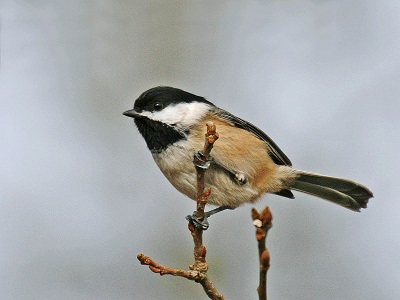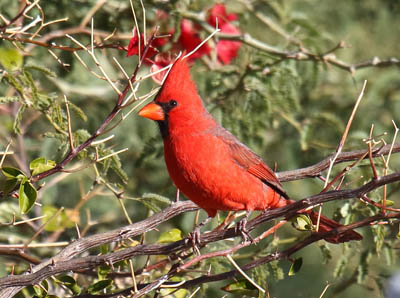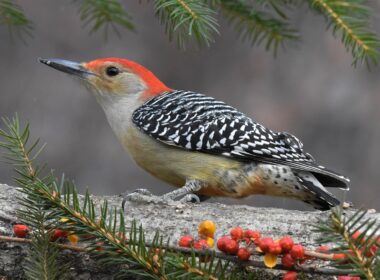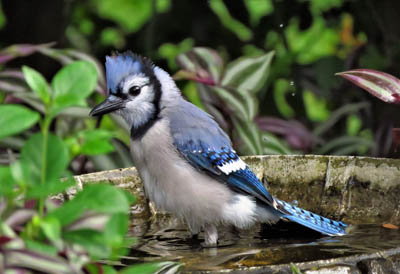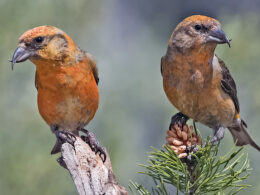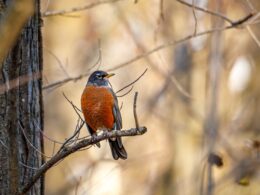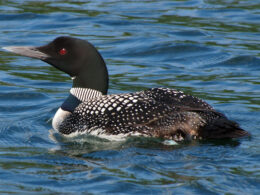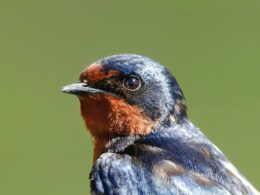Last Updated on January 5, 2024 by Greg Gillson
Did you see a brightly-colored red bird, orange bird, or yellow bird in California and wonder what is was?
This page is for you!
This article shows you photos and identification of some of the most common birds in California based on color.
The list of birds found in California includes over 675 species. About 450 species are commonly seen every year. So, I can’t show you all of them. I’m going to assume that you saw a common bird of this color, but you certainly could have seen something less common, or even rare!
Shape (including the shape of the bill) and size are often more helpful in starting to identify a bird than the color. In fact, most birds in North American can be easily identified with a black-and-white photo!
Many birds are multi-colored, so that it may be hard to pick out a dominant color. Males and females may be colored quite differently. And some color patterns are similar among otherwise dissimilar species.
Nevertheless, I’m going to try to pick out some of the birds that you are most likely to see in backyards or towns. And I’ll show a few others that I get asked about a lot.
The birds with a noticeable amount of red on them in California covered in this article are:
- House Finch
- Purple Finch
- Red-breasted Sapsucker
- Anna’s Hummingbird
- Red-breasted Nuthatch
- American Robin
- Spotted Towhee
- Vermilion Flycatcher
The birds with a noticeable amount of orange on them in California covered in this article are:
- Northern Flicker
- Allen’s Hummingbird
- Bullock’s Oriole
- Hooded Oriole
- Black-headed Grosbeak
- Barn Swallow
- Cinnamon Teal
The birds with a noticeable amount of yellow on them, including lots of yellow and black birds, in California covered in this article are:
- Lesser Goldfinch
- American Goldfinch
- Western Tanager
- Common Yellowthroat
- Yellow-rumped Warbler
- Townsend’s Warbler
- Yellow Warbler
- Western Meadowlark
- Western Kingbird
- Evening Grosbeak
Red birds of California
Birds get the red, orange, and yellow in their feathers from carotenoids in the fruit, seeds, and plants they eat (source).
These carotenoid colors combine with melanin to form an infinite range of red feathers–pink, rusty, scarlet, violet, red-orange.
The following are red birds that you are most likely to see in California.
House Finch
When people ask about a bird with a red head at their feeder, it is usually this bird.
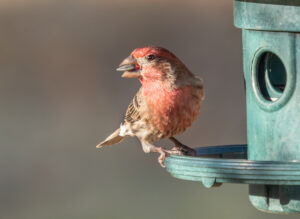
Males of this dusty brown striped finch have red limited to the head (specifically the forehead and eyebrow), breast (chest), and rump. The red coloration tends toward orangish, and may rarely be yellowish.
Females are streaked, similar to the males but without red. They lack any strong pattern on the face and head.
Note the small round head and curved upper ridge on the bill.
Some people call these red-headed sparrows. Sparrows and finches are similar, but in general, male finches are brighter than the females and tend to hang out more in trees. Sparrow genders are usually quite similar in coloration and tend to feed mostly on the ground.
These birds are common in residential areas, especially at bird feeders. In the West more widespread in arid regions near water.
House Finches are year round residents throughout California.
Purple Finch
Forest finches of the foothills, delicately frosted in pinkish-red.
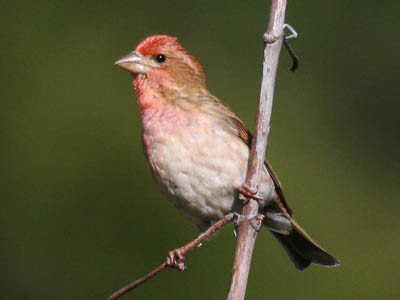 |
| Male Purple Finch. Greg Gillson. |
Told from more common House Finch by bigger square or peaked head, bigger bill, lacks sharp striping below, deeply notched tail. Red covers all plumage.
Females lack red color, shows strongly patterned dark ear patch outlined all around with a pale stripe, is heavily streaked below.
Found in foothills and damp mountains conifers and mixed woods. Visit feeders, but less frequently than House Finches.
Purple Finches are year-round residents in California, more widespread in northern California, especially in winter.
Red-breasted Sapsucker
If you see a “red-headed woodpecker” in the West, it is likely this common species.
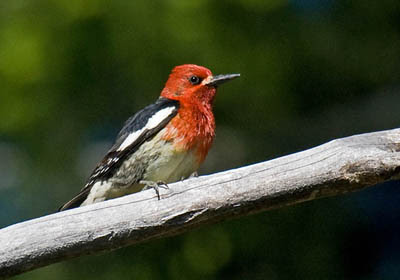 |
| Red-breasted Sapsucker. Greg Gillson. |
The red covers the entire head and upper breast. Northern populations are deeper red; those in California paler, often with white line down neck from bill. The bold white wedge in the wing is typical of all sapsuckers.
They live in mixed woods and mountain forests. Visit orchards, parks in winter.
Red-breasted Sapsuckers are widespread year-round residents in northern California. In southern California they are restricted to mountain forests, but may stray to lowlands in winter.
Anna’s Hummingbird
These are larger hummingbirds with red heads that don’t migrate.
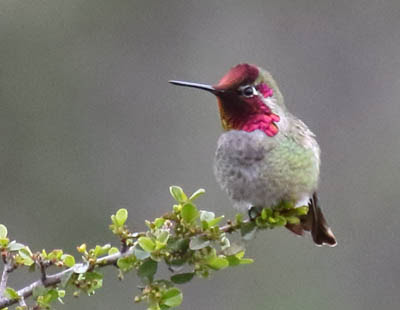 |
| Male Anna’s Hummingbird. Greg Gillson. |
These are big green hummingbirds. Adult males have the entire head red–forecrown and throat, actually. The color of the iridescent feathers is amethyst, a bright reddish purple color, tending towards pink.
Young males have just a spot of red on the center of the throat.
Females lack red, but often show a spot of iridescent green feathers on the center of the white throat. The upper breast is gray. The lower belly and flanks have a greenish tinge. Many other western hummingbird species have cinnamon color under the tail.
They are common in flower gardens and hummingbird feeders year-round.
Anna’s Hummingbirds are year-round residents throughout California at lower elevations.
Red-breasted Nuthatch
These active little red-breasted birds crawls all around on the trunk and big branches of conifers. They search crevices in the bark for insect food.
 |
| Red-breasted Nuthatch. Greg Gillson. |
These tiny birds have blue-gray backs and a black line through a white face. Some males can have quite bright rusty red under parts. Some females can have quite pale buff-colored under parts. Most birds show an orange-cinnamon breast color.
Found nearly exclusively in conifers. Readily come to feeders.
Red-breasted Nuthatches are year-round residents throughout California. They are more widespread in northern California and restricted to mountains and coastal conifers in southern California.
American Robin
These are familiar lawn birds with red breasts.
 |
| American Robin. Greg Gillson. |
Male American Robins are brownish-gray above with a brick red breast. Females are paler orange below and paler gray above.
They are widespread in open country with scattered deciduous trees, residential areas.
American Robins are year-round residents throughout much of California. In southern California they are more limited to the mountains. They are only found in the southeastern deserts in winter.
Spotted Towhee
These big sparrows with red sides superficially resemble the coloration of a robin.
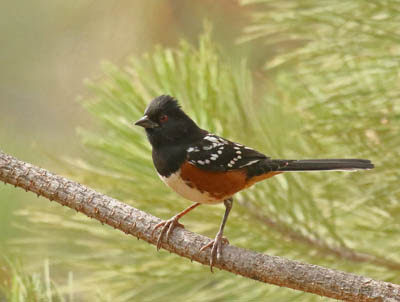 |
| Spotted Towhee. Greg Gillson. |
These birds have dark hoods and upper parts with rusty rufous-red sides and white bellies. They have white spots over their wings, shoulders, and on their tail corners. The upper parts of the males are jet black, females dark brown. Some populations have paler orange sides.
These are somewhat shy birds that hide in the dense brush and spend most of their time on the ground. They visit feeders during quiet periods.
Spotted Towhees are year-round residents through most of California. They are only found in the mountains in summer. They are only found in the deserts in winter.
Vermilion Flycatcher
These small desert birds are a glowing hurt-your-eyes red!
 |
| Male Vermilion Flycatcher. Greg Gillson. |
Males are brilliant red on the crown and underparts. The back, wings, and tail are dark sooty brown.
Females and immature birds are paler. They are more grayish brown above, white below with streaked breast and belly that may be peachy yellow to orange-pink.
They are found in deserts near water, pastures, golf courses, ball fields.
Vermilion Flycatchers are very rare and local residents in southern California. They are more widespread in winter in coastal southern California.
Orange birds of California
True orange-colored birds are not that common. Many birds that I show here are paler rusty-orange b.
The common pattern is an orange body and black or brown wings and tail. Another common pattern is for the orange to be restricted to the under parts.
The following are orange birds that you are most likely to see in California.
Northern Flicker
These unusual woodpeckers with orange under wings are just as likely to be found hopping on your lawn eating ants as they are to be calling from a dead tree top.
 |
| Northern Flicker. Greg Gillson. |
Where is the orange color?
Wait for it…
 |
| Northern Flicker. Greg Gillson. |
The shafts and undersides of the wing and tail feathers are a salmon orange color. A large white rump patch also attracts attention as these birds fly away.
Northern Flickers live in open woods, residential areas. Sometimes visit feeders in winter.
Northern Flickers are year-round residents throughout most of California. Birds are only in the high mountains ins summer. Birds also move into the desert in winter.
Allen’s Hummingbird
These small hummingbirds appear to be all rusty orange as they fly by.
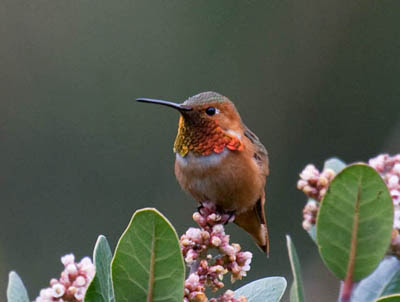 |
| Male Allen’s Hummingbird. Greg Gillson. |
These birds are rusty-orange on the face, rump, and tail feathers. They have cinnamon pink belly and under parts. The males have a brilliant red throat gorget. Females have a white throat streaked with thin green feathers.
Very similar to Rufous Hummingbirds. Male Rufous Hummingbirds have rufous backs; male Allen’s Hummingbirds have green backs. Females are only told apart by measuring widths of some of the tail feathers.
They live in dense wet coastal shrubland. Come to feeders.
Allen’s Hummingbirds are restricted to the coastal areas of California. Most are summer visitors only, the length of the state. However there is a small population that remain year-round in southern California, near Los Angeles and on some offshore islands.
Bullock’s Oriole
These bright orange and black birds are often seen in tall trees.
 |
| Male Bullock’s Oriole. Greg Gillson. |
The males of this species are very bright orange. The back and top of the heads are black. The black wings have large white wing patches. The tail is black with orange sides. The face is orange with a black line through the eye and a black throat.
Females and young are gray with yellow head and breast and tail.
These birds are more common in drier inland regions along watercourses in tall cottonwoods or shade trees. Rarely come to feeders for fruit or nectar in spring.
Bullock’s Orioles are summer residents throughout California below high mountains and away from thick forests.
Hooded Oriole
In the United States no other bird is so closely associated with palm trees as this bright orange oriole.
 |
| Male Hooded Oriole. Greg Gillson. |
Males of the western population are yellow-orange. Texas populations are more orange. The whole head is orange except for the black face and throat. The tail is solidly black, as seen in flight.
Females are yellow-green above and quite yellow below.
These birds are found in residential areas, parks, closely tied to Washingtonia palms.
Hooded Orioles are summer residents throughout southern California. They are less common in the Central Valley and westward to the coast.
Black-headed Grosbeak
If you didn’t look closely at these big-billed birds, you might mistake these orange-breasted songsters for American Robins–their coloration and song are very similar!
 |
| Male Black-headed Grosbeak. Greg Gillson. |
Males have black and white wings and tail. Huge bill. The under parts are burnt orange, fading to yellow-orange mid-belly.
Females and first year birds have a striped heads and are brown above, pale buff or butterscotch-orange below.
These birds are found in deciduous or mixed woods. Visit bird feeders.
Black-headed Grosbeaks are summer residents throughout most of California, but migrants only in the southern deserts.
Barn Swallow
These orange-bellied birds are a familiar sight across North America in summer.
 |
| Barn Swallow. Greg Gillson. |
These birds are purple-blue above with orange under parts and long forked tails. The color of the underparts in winter or on females are often cinnamon or buff-colored, but breeding males can be brighter orange-red.
These birds swoop low over fields and wetlands at lower elevations. They may build their mud nests in rafters on porches, garages, or other out-buildings.
Barn Swallows are summer residents throughout most of California.
Cinnamon Teal
What an unusually colored brownish-orange duck!
 |
| Male Cinnamon Teal. Greg Gillson. |
Males are dark cinnamon orange. The wing patches are blue, green, and white. The eye is red.
Females are more mottled brown with matching wing patches.
These birds are found in ponds and grass-lined ditches.
Cinnamon Teals are year-round residents in middle and southern California at lower elevations. They are summer residents throughout California.
Yellow birds of California
Yellow is a common bird color! Often it is mixed with black and white plumage in birds.
Many birds with darker upper parts have yellow breast or belly.
The following are yellow birds you are most likely to see in California.
Lesser Goldfinch
Lesser Goldfinches maintain their bright yellow plumage all year–even in the winter when American Goldfinches are rather brown and colorless.
 |
| Male Lesser Goldfinch. Greg Gillson. |
These tiny birds are bright yellow below (including under the tail), and green or black on the back. The wings and tail are black and white. Males have a black cap, which the females lack.
These birds are found near water in arid regions of the West and Southwest. They are common in residential areas, too, and come to bird feeders.
Lesser Goldfinches are year-round residents throughout California, except in conifer forests and higher mountains.
American Goldfinch
These small little birds are bright yellow and black.
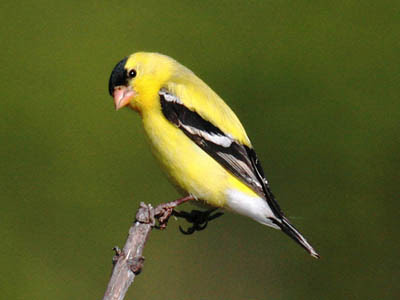 |
| American Goldfinch. Greg Gillson. |
Males are bright lemon yellow with black and white wings and tail, black cap. White under tail coverts. Pink bill.
Females are duller yellow below and brownish above. Lack black cap.
Winter birds are pale brown or gray, a touch of yellow on the throat of males.
These are birds of open country, fields with saplings, clear cuts, residential areas. They avoid dense forests, mountains, deserts. They visit feeders.
American Goldfinches are year-round residents throughout lower agricultural and residential areas of California.
Western Tanager
Numbers of these bright black and yellow birds may show up overnight in backyards in spring migration. Then they disappear the next night.
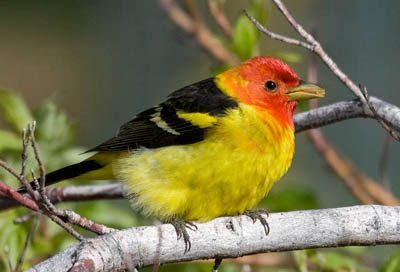 |
| Western Tanager. Greg Gillson. |
Males are brilliant golden yellow with black back, wings, and tail, and a red or orange face. Swollen yellow bill.
Females are more green or gray, with darker wings and tail. Lack red face.
They are found in a variety of wooded habitats, usually conifers or mixed conifer woods, and residential areas with large trees, including mature conifers. Usually don’t visit feeders.
Western Tanagers are summer residents in conifer woods and mountains throughout California, especially in northern California. Spring migrants are widespread throughout California, including deserts.
Common Yellowthroat
These buttery yellow birds are abundant in the marsh vegetation.
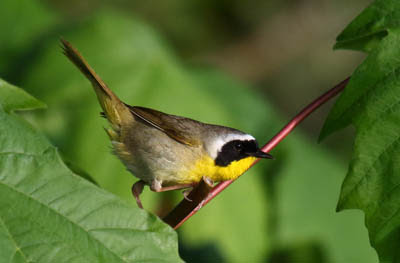 |
| Male Common Yellowthroat. Greg Gillson. |
These skulkers have bright yellow throats and yellow undertail coverts. Males have a black domino mask edged broadly in white, which females lack. Upperparts are dull olive-green.
Immature males in fall show a shadowed black mask.
Found in damp situations and heavy deciduous brambles following clear cuts.
Common Yellowthroats are summer residents throughout California. Winter in mid and southern California lowlands, especially coastally.
Yellow-rumped Warbler
These are abundant warblers across North America. Affectionately called “butter butts” by many birders, because of their bright yellow rumps that flash in flight.
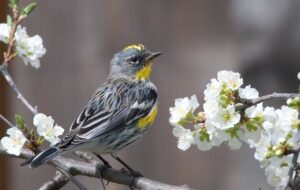 |
Western form (Audubon’s) with bright yellow throat and yellow rump. Large white wing patch.
Northern and Eastern form (Myrtle) with white throat, yellow rump, and two white wing bars.
Winter birds are dull gray brown, with bright yellow rump. Throat may be cream colored or white. Often difficult to tell the two forms apart in winter.
 |
| Winter Yellow-rumped Warbler. Greg Gillson. |
Breed in mountain or boreal conifers. Widespread in migration. Winter in low river bottoms, open weedy deciduous areas. Rarely come to feeders in winter.
Yellow-rumped Warblers are year-round residents in conifer forests in coastal northwestern California, summer residents in high mountain forests. Local and northern breeding birds winter throughout California at lower altitudes.
Townsend’s Warbler
What beautiful woodland birds–yellow with striking black patterns on the head and face!
 |
| Male Townsend’s Warbler. Greg Gillson. |
These little birds have yellow face and breast. Black crown, ear patch. Black throat on male, lacking on female. Back is green. Wings gray with two wide white wing bars. Show dark gray tail with white outer tail feathers in flight.
Breeds in conifer mountain forests. Winters in lowlands, oaks and conifers, residential trees.
Townsend’s Warblers winter coastally the length of California. Found throughout California in spring and fall migration.
Yellow Warbler
The golden yellow sun packed all into one little bird! Appears to be an all-yellow bird.
 |
| Yellow Warbler. Greg Gillson. |
Some populations are bright yellow, some tend toward greenish on upper parts, some more golden. Yellow internal tail corners in flight.
Males with red breast streaking, again, variable by population.
Females somewhat to much paler yellow, some greenish, some whitish. Lack red streaks.
These birds are found in willow thickets on the edge of wetlands and ditches, stream sides in arid regions.
Yellow Warblers are summer residents throughout much of California below the mountain forests.
Western Meadowlark
These are streaky camouflaged prairie birds from above or from behind. But from the front, the breast is shocking yellow!
 |
| Western Meadowlark. Greg Gillson. |
They are streaked brown, black, and gray on the upper parts. The underparts are golden yellow with a black necklace crossing the upper breast. Much paler yellow in fall and winter, as the yellow feathers are tipped with white and streaked with brown.
These are birds of pastures and grasslands and arid regions.
Western Meadowlarks are year-round residents in California away from forests and below mountains. Supplemented in winter by birds from the north.
Western Kingbird
These yellow-bellied birds of the prairies often perch on power lines and fence lines.
 |
| Western Kingbird. Greg Gillson. |
These birds are pale gray on the head and breast. Brown wings. The belly is lemon yellow. Black tail has white outer tail feathers, especially obvious in flight.
These are birds of prairies, deserts, pastures, often near water.
Western Kingbirds are summer residents throughout California away from dense forests, high mountains, and the immediate coastline.
Evening Grosbeak
These large yellow northern finches are usually found in flocks.

Males are brilliant yellow, with black and white wings. Dusky brown head with bold yellow eyebrow. Huge thick yellow-green bill. White wing patches in flight.
Females are grayer with yellow hind collar, black and white wings. Huge yellow-green bill.
These are birds of northern conifer forests. They often descend to the lowlands in spring to eat seeds of maples, elms.
Evening Grosbeaks are year-round residents in northern California and southward in mountains. Irregularly in winter, when cone crops fail in the north, they irrupt southward the length of the state.
Wrapping Up
The vibrant reds, yellows, and oranges of California birds come from a fascinating interplay of several factors, including:
Pigmentation:
- Carotenoids: These pigments found in fruits, insects, and other food sources are absorbed by birds and deposited in their feathers, producing vibrant yellow, orange, and red colors. For example, the orange breast of the Western Tanager comes from consuming insects rich in carotenoids.
- Melanin: This pigment is responsible for brown, black, and gray colors in feathers. However, its distribution and interaction with other pigments can also influence red and orange hues. For example, in the Anna’s Hummingbird, the fiery orange throat results from a combination of red carotenoids and black melanin concentrated in specific feather structures.
Light interaction:
- Iridescence: Some feathers have microscopic structures that diffract light, creating shimmering rainbow effects and flashes of color like the green throat of the Anna’s Hummingbird. This iridescence can add depth and brilliance to red, yellow, and orange pigments.
- Structural coloration: Certain feather structures, like tiny air pockets or keratin layers, can reflect specific wavelengths of light, producing vibrant colors without pigments. For example, the blue head of the California Scrub Jay is primarily due to structural coloration, not blue pigments.
Evolutionary pressures:
- Camouflage: In some cases, bright colors might serve as camouflage in specific environments. For example, the yellow plumage of the Common Murre might blend with the sunlight reflecting off the water.
- Communication and courtship: Vibrant colors often play a role in communication and attracting mates. The striking red head of the Western Tanager, for instance, is a prominent display feature during courtship.
- Species recognition: Distinct color patterns can help different bird species recognize each other, reducing competition and facilitating breeding success.
Frequently Asked Questions
What is the difference between a Hooded Oriole and a Bullock’s Oriole?
Both hooded and Bullock’s orioles are vibrant orange songbirds found in North America, but they can be surprisingly easy to tell apart with a few key features. Here’s a breakdown of their differences:
Hooded Oriole:
- Head & Neck: Vivid orange with a distinct black bib and face mask, resembling a small hood.
- Wings: Large white wing patch at the base of the primaries, easily visible in flight.
- Song: Clear, flute-like melody with frequent repetitions of “hoo-dee-doo.”
- Habitat: Prefers deciduous forests and riparian areas with thick foliage.
Bullock’s Oriole:
- Head & Neck: Blacker overall, with only a thin black line extending down the throat, no full mask.
- Wings: Smaller white wing patch or sometimes none at all, less noticeable in flight.
- Song: More rasping and variable, with a distinct “chuck” sound and less repetition.
- Habitat: Favors more open landscapes like semi-arid woodlands, farmland, and city parks.
Additional Distinguishing Features:
- Bill: Hooded Oriole has a slightly curved bill, while Bullock’s has a straighter bill.
- Tail: Hooded Oriole has a longer, deeper V-shaped tail compared to Bullock’s.
- Female Plumage: Both females are duller with less orange, but hooded females often retain some black facial markings, while Bullock’s females appear more streaked and lack the black mask.
Range:
- Hooded Oriole: Eastern North America, from the Great Plains to the Atlantic coast.
- Bullock’s Oriole: Western North America, from the Rocky Mountains to the Pacific coast.
Are all towhees orange?
Not all towhee birds are orange! While some species boast vibrant orange plumage, others exhibit different colors and patterns. Here’s a closer look at the diversity of towhee coloration:
Orange Towhees:
- Eastern Towhee: These iconic North American birds feature a striking black head and upper body, contrasting with their rusty orange chest and sides.
- Spotted Towhee: Found in the western US, these towhees have black upperparts covered with white spots, and their flanks range from warm orange to reddish brown.
- California Towhee: These California residents sport a rich brown body with a rusty orange patch under the tail, giving them the scientific name Melozone crissalis (crissalis meaning “rump” in Latin).
Why does the Northern Flicker have orange under the wings?
The vibrant orange feathers under the wings of the Northern Flicker are a fascinating element of their plumage, serving multiple purposes that contribute to their survival and success:
1. Camouflage: Contrary to what you might think, the orange patch isn’t solely for flashiness. When the flicker folds its wings during flight, the orange flashes briefly, potentially mimicking sunlight filtering through leaves and momentarily camouflaging the bird against the forest canopy as it dives down to catch prey on the ground. This quick burst of color might confuse potential predators or insects, giving the flicker an edge in the hunt.
2. Communication and Display: The orange underwings can also play a role in communication and courtship. During territory defense or aggressive displays, the flicker might flash its orange plumage, acting as a visual warning to rivals or potential threats. In courtship rituals, males might spread their wings and display the orange patches to attract mates, showcasing their strength and fitness.
3. Distraction and Decoy: Some experts suggest the orange flash might even function as a distraction tactic. While a predator focuses on the sudden splash of color, the flicker has a chance to escape unseen or maneuver to a safer position. Additionally, the orange patch might resemble an open eye, potentially confusing predators and causing them to hesitate or divert their attention.
4. Species Recognition: The distinct orange underwing patch could also play a role in species recognition, helping different flicker populations or even sexes identify each other within the crowded avian world. This clear visual signal might facilitate communication and breeding success within their own species.
________________________________________________________________________________________________
Related Articles:
See photos and learn about the most common backyard birds in California, regardless of color.
See the photos and learn what to feed the winter birds in California.
Here’s a quick tutorial of how I would teach you to identify birds: 7 Steps to Identify Birds!
Birds with red heads in North America.
Yellow-and-black birds in North America.


